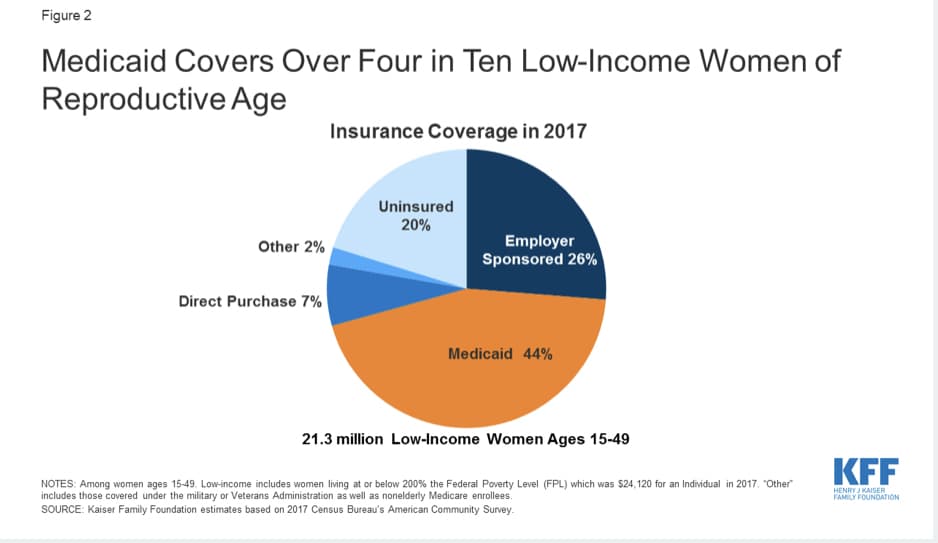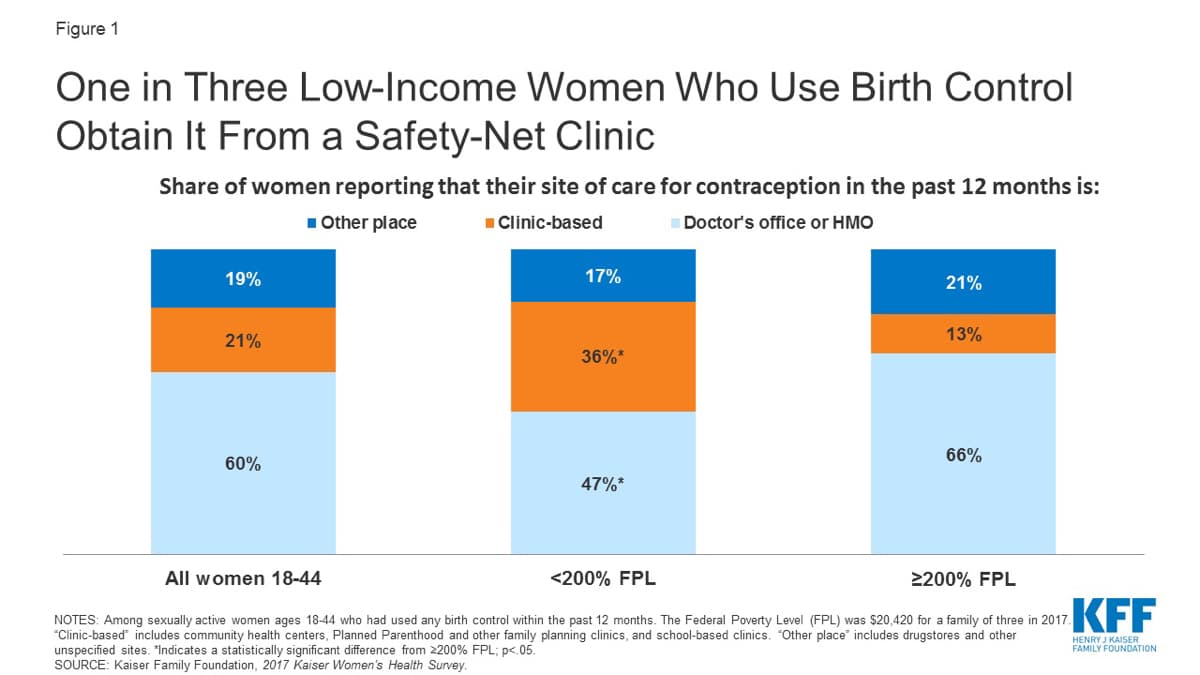Figure 1 One in Three Low-Income Women Who Use Birth Control Obtain It From a Safety-Net Clinic Share of women reporting that their site of care for contraception in the past 12 months is: ■ Other place Clinic-based Doctor's office or HMO 19% 21% 60% All women 18-44 17% 36%* 47%* 21% 13% 66% <200% FPL ≥200% FPL NOTES: Among sexually active women ages 18-44 who had used any birth control within the past 12 months. The Federal Poverty Level (FPL) was $20,420 for a family of three in 2017. "Clinic-based" includes community health centers, Planned Parenthood and other family planning clinics, and school-based clinics. "Other place includes drugstores and other unspecified sites. *Indicates a statistically significant difference from 2200% FPL; p<.05. SOURCE: Kaiser Family Foundation, 2017 Kaiser Women's Health Survey. KFF HENRY J KAISER FAMILY FOUNDATION
Figure 1 One in Three Low-Income Women Who Use Birth Control Obtain It From a Safety-Net Clinic Share of women reporting that their site of care for contraception in the past 12 months is: ■ Other place Clinic-based Doctor's office or HMO 19% 21% 60% All women 18-44 17% 36%* 47%* 21% 13% 66% <200% FPL ≥200% FPL NOTES: Among sexually active women ages 18-44 who had used any birth control within the past 12 months. The Federal Poverty Level (FPL) was $20,420 for a family of three in 2017. "Clinic-based" includes community health centers, Planned Parenthood and other family planning clinics, and school-based clinics. "Other place includes drugstores and other unspecified sites. *Indicates a statistically significant difference from 2200% FPL; p<.05. SOURCE: Kaiser Family Foundation, 2017 Kaiser Women's Health Survey. KFF HENRY J KAISER FAMILY FOUNDATION
Case Studies In Health Information Management
3rd Edition
ISBN:9781337676908
Author:SCHNERING
Publisher:SCHNERING
Chapter1: Data Content, Structure, And Standards
Section: Chapter Questions
Problem 1.14.1C
Related questions
Question
Based on the two given images what do you see and what do you notice?

Transcribed Image Text:Figure 2
Medicaid Covers Over Four in Ten Low-Income Women of
Reproductive Age
Other 2%
Direct Purchase 7%
Insurance Coverage in 2017
Uninsured
20%
Employer
Sponsored 26%
Medicaid 44%
21.3 million Low-Income Women Ages 15-49
NOTES: Among women ages 15-49. Low-income includes women living at or below 200% the Federal Poverty Level (FPL) which was $24,120 for an Individual in 2017. "Other"
includes those covered under the military or Veterans Administration as well as nonelderly Medicare enrollees.
SOURCE: Kaiser Family Foundation estimates based on 2017 Census Bureau's American Community Survey.
KFF
HENRY J KAISER
FAMILY FOUNDATION

Transcribed Image Text:Figure 1
One in Three Low-Income Women Who Use Birth Control
Obtain It From a Safety-Net Clinic
Share of women reporting that their site of care for contraception in the past 12 months is:
■ Other place
Clinic-based
Doctor's office or HMO
19%
21%
60%
All women 18-44
17%
36%*
47%*
21%
13%
66%
<200% FPL
≥200% FPL
NOTES: Among sexually active women ages 18-44 who had used any birth control within the past 12 months. The Federal Poverty Level (FPL) was $20,420 for a family of three in 2017.
"Clinic-based" includes community health centers, Planned Parenthood and other family planning clinics, and school-based clinics. "Other place includes drugstores and other
unspecified sites. *Indicates a statistically significant difference from 2200% FPL; p<.05.
SOURCE: Kaiser Family Foundation, 2017 Kaiser Women's Health Survey.
KFF
HENRY J KAISER
FAMILY FOUNDATION
Expert Solution
This question has been solved!
Explore an expertly crafted, step-by-step solution for a thorough understanding of key concepts.
Step by step
Solved in 2 steps

Knowledge Booster
Learn more about
Need a deep-dive on the concept behind this application? Look no further. Learn more about this topic, biology and related others by exploring similar questions and additional content below.Recommended textbooks for you

Case Studies In Health Information Management
Biology
ISBN:
9781337676908
Author:
SCHNERING
Publisher:
Cengage

Human Heredity: Principles and Issues (MindTap Co…
Biology
ISBN:
9781305251052
Author:
Michael Cummings
Publisher:
Cengage Learning

Biology: The Unity and Diversity of Life (MindTap…
Biology
ISBN:
9781305073951
Author:
Cecie Starr, Ralph Taggart, Christine Evers, Lisa Starr
Publisher:
Cengage Learning

Case Studies In Health Information Management
Biology
ISBN:
9781337676908
Author:
SCHNERING
Publisher:
Cengage

Human Heredity: Principles and Issues (MindTap Co…
Biology
ISBN:
9781305251052
Author:
Michael Cummings
Publisher:
Cengage Learning

Biology: The Unity and Diversity of Life (MindTap…
Biology
ISBN:
9781305073951
Author:
Cecie Starr, Ralph Taggart, Christine Evers, Lisa Starr
Publisher:
Cengage Learning

Biology: The Dynamic Science (MindTap Course List)
Biology
ISBN:
9781305389892
Author:
Peter J. Russell, Paul E. Hertz, Beverly McMillan
Publisher:
Cengage Learning

Nutrition Through The Life Cycle
Health & Nutrition
ISBN:
9781337919333
Author:
Brown, Judith E.
Publisher:
Cengage Learning,
